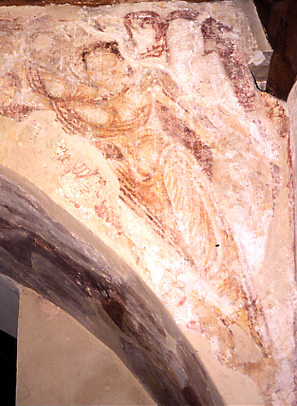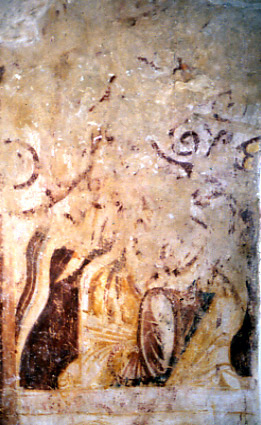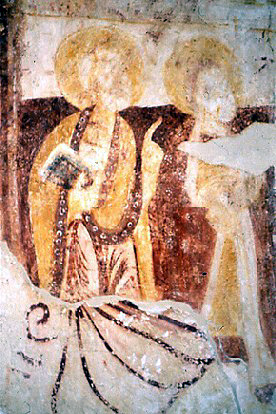West Chiltington, Sussex (†Chichester) C.12
Supporting angels & apostles, (Christ In Majesty)

These fragmentary paintings, by far the earliest of those at West Chiltington, are at the east end of the south aisle. They were originally part of a Christ in Majesty (Maestà), but this, painted in an aureole in a similar manner to the later example at Houghton Conquest, has almost entirely disappeared.
Three or perhaps four of the angels flanking it on the right remain however. They once held censers, and the chains on which these swung can be seen curving gracefully towards the implied centre of the painting. Lower down the body of the leading angel furthest to the left, the equally graceful curves of typical 12th century painted draperies can be seen.

The massiveness of 12th century arches meant that their curved inner surfaces, or soffits, were often painted with figurative scenes – as opposed to scrollwork decoration and the like – and something of this can be seen in the photograph above.
At West Chiltington, the upper parts of these soffits had two seated angels, one on either side, painted as though holding up the vanished aureole placed centrally above them. Only fragments of them remain, but that on the north (left) soffit of the arch (detail, left) shows something of the monumental quality of these figures. The lower legs, knees and feet (i.e. the lighter areas flanking the ovoid whorl of drapery placed centrally near the bottom) give some idea of the imposing and impressive nature of the original. The seated Apostle, of around the same date, at Little Easton provides a useful stylistic comparison.

The clearest remaining 12th century fragment, though, is that painted directly below the seated angel shown and discussed above. This (detail, right) shows two haloed Apostles (there are another two, less clear, below the corresponding but fragmentary angel on the other soffit of the arch).
The figure at the left is particularly fine. He carries a book, which may mean he is an Evangelist, and has a richly ornamented border to his mantle. His gesture, with left-hand index finger extended, may be intended as indicating the heavenly grandeur above, or may simply signify speech. Quite possibly both meanings are here.
The scrollwork ornament visible in some of the photographs is from a later date. West Chiltington is unusual in that it has at least the remains of paintings from all centuries from the twelfth to the fifteenth. The 13th century Passion Cycle and the 15th century Warning to Sabbath Breakers are already on the site, and others will be here soon. But the very early paintings on this page may be virtually the same age as the building itself, and we know that this was built sometime between 1100 and 1150.